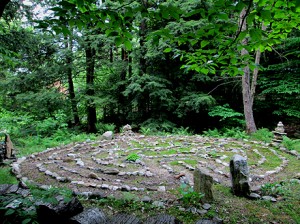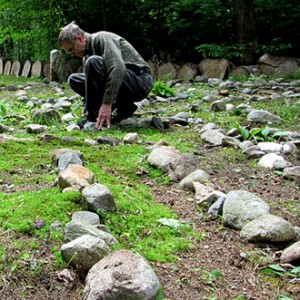 I move through the labyrinth on my knees, like a supplicant on a pilgrimage to a holy place. I pluck every dandelion, every blade of grass. Seedling trees and other wayward plants nearly obscure the stones that mark a path to the center. I must remove them, too.
I move through the labyrinth on my knees, like a supplicant on a pilgrimage to a holy place. I pluck every dandelion, every blade of grass. Seedling trees and other wayward plants nearly obscure the stones that mark a path to the center. I must remove them, too.
Every spring the same exercise awaits me. I make my way, revealing the path, inch by inch and foot by foot. Where the moss threatens to envelope a rock, I pull up the rock and turn it over—showing another side, darkly moist but clean of moss. It sharpens the edges of the path.
In the labyrinth, clearing and clarifying the path take time and patience. All vegetation except the moss must go. Even the rocks may need to shift slightly. Some need to be turned over or repositioned after winter’s frost and settling. Each stone helps mark the path. I make the labyrinth my metaphor as my queer life turns, inward and then outward, perpendicular to and then parallel to a center. But as I follow the path, I trust it will lead inexorably toward a center.
When I designed this labyrinth, I purposefully made it novel. I did not follow the classical, Roman or medieval pattern. This path does not come from England, Coimbra, or Chartres. It comes from the deeps of my gay old soul. It has seven circuits around its center and honors the four directions. Its design nods to the earthy sensibilities of my faerie brothers. Stone assemblages mark the four directions, tapping into primitive and celtic influences passed on by on the spiritual journeys of my gay old soulmate, closest friends, and queer elders.
Like our journeys, this path moves inevitably toward a center but never in a straightforward way. I progress sometimes closer to and sometimes farther from that center. But each turn away from the center takes a necessary course to finally reach it.
Today, my task of weeding keeps me on my knees, an attitude that has implications in both my spiritual and sexual reality, I note that with wry pleasure. God, the body, and intimate relationships never stray far from each other. They seek union even as they seek the same center. Keeping the path clear for all three aids their quest. So I maintain the path as it turns and returns.
 I make this my physical prayer; a wordless mediation. I tend the way for today. Others will follow—perhaps long after I have gone. They will find different items to clear from the path, new weeds grown, a freshly fallen twig, perhaps even a tree downed by the wind that requires rebuilding the path and its stations from scratch and from that pilgrim’s own experience.
I make this my physical prayer; a wordless mediation. I tend the way for today. Others will follow—perhaps long after I have gone. They will find different items to clear from the path, new weeds grown, a freshly fallen twig, perhaps even a tree downed by the wind that requires rebuilding the path and its stations from scratch and from that pilgrim’s own experience.
But this is my task for this hour. As I live and move, bent to my purpose, I make my way as a gay old pilgrim, ever more surely toward the center.

